Patricia Walsh’s blind ambition
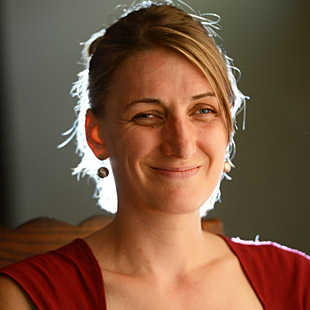
When Patricia Walsh pushed the doorbell on time for her interview at a friend’s Austin, Texas home, I looked outside for a car or a taxi that brought her there. Nada. Only when pressed to explain did she say that she had walked from her home to a bus stop, made a connection, and walked a mile to his house on a 94 degree day.
The day before, Walsh, working with guide Angie Balentine at the Cap Tex Triathlon in Austin, won the USAT Paratriathlon national championship women’s title in the TRI 6 category for legally blind competitors. Her time of 1:18:25 won her category by 4:27 and that time was 5th overall among women at the sprint distance. Walsh was just 51 seconds back of the third place overall woman.
Last year, in just her second year of triathlon, Walsh broke the record for blind women triathletes at the Ironman distance by 4 hours and also beat the mark for the fastest Ironman by a blind man by 55 minutes at Ironman Texas. After that, she won her first USAT Paratriathlon Championship in the TRI 6 category in New York and wrapped up the year with a women’s third place finish in the blind category at the ITU Paratriathlon World Championship in Beijing.
The 31-year-old Walsh emerged from the trauma of becoming totally blind at age 14 to earn a degree in computer science and electrical engineering at Oregon State, then worked for Microsoft before embarking on a career in public speaking and consulting early this year. One of her long term goals is to raise her game to qualify for the 2016 Paralympics as a runner.
Slowtwitch: What led you into triathlon?
Patricia Walsh: It was 2009 and I had been a marathon runner for about 10 years but I suffered some injuries and my interest was waning. A good friend of mine fixed up a tandem bike and he and I went riding all over town. I hadn’t been on a bike since I was a kid, certainly not since I lost my vision. It was just the most exciting thing ever. I loved the wind in my hair. The next day I was having coffee with a friend who had done two Ironmans and he asked if I ever considered doing one. I don’t think he thought I would sign up for next year’s Ironman Lake Placid in the next 30 minutes – which I did. But I only know one way to be. My friends can attest I am a person who signs on pretty quickly.
ST: What was the first thing you did to prepare?
Patricia: I did not know how to swim freestyle, so I went to a pool and did my doggy paddle but I miscalculated the distance and it turns out I did 4 miles. I got sick and quickly determined swim classes were in order.
WHEN BLINDNESS HIT
ST: When did you start to lose your vision?
Patricia: I had a brain tumor when I was 5 years old and I was in the hospital in Seattle for six months after doctors removed it. At this time my parents were getting divorced and I lost the bulk of my vision. So it was sort of a perfect storm.
ST: What are the classifications of blindness, and what were yours?
Patricia: The highest category of blindness is B-1, which is termed no residual vision. That’s where I am today. B-2 is when you have some residual vision — lights and blobby shapes. B-3 is what we consider legally blind, where you can see some shapes but you can’t qualify for a driver’s license.
ST: What category were you?
Patricia: I had low vision in that B-2 range until I was 14, when I had complications from post-operative scarring and lost the rest of my vision. I do have a very narrow 5 degree field of slight visual impression – imagine looking through a paper towel tube and you can only tell if the light in the small circle is on or off.
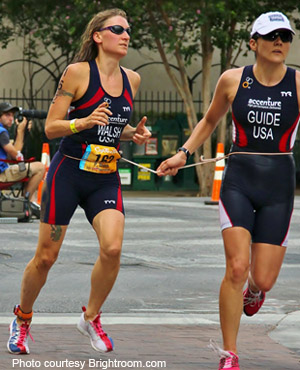
ST: What sports could you do as a kid?
Patricia: I was pretty athletic in high school — running mostly. [With no separate division for blind athletes, she qualified for the Ontario, Canada high school provincial finals in the 100- and 200-meter dash]. I also managed the basketball team. I would practice but I was never on the court in a competitive game.
ST: Losing your already limited vision must have been traumatic?
Patricia: I was devastated. I was 14 and I didn’t have lot of support at home, so I knew I would have to fend for myself. I think a lot of people will echo the sentiment that when you lose a physical ability or you lose a sense, you feel like damaged goods for a time. You don’t know what your identity is, or your worth.
ST: What was your first concern?
Patricia: I really wanted to be the same socially. Excuse me for being petty, but I was 14 and hated that people could know I was blind and felt sorry for me. So I trained myself to look directly at people who spoke to me. I set up alarm clocks in a room and spent 10 hours a day practicing to look right at the clocks when they rang.
ST: You were determined!
Patricia: I was goal-oriented from the moment I came out of the womb. There hasn’t been a moment in my life that I wasn't.
ST: When did you start to take courses?
Patricia: I went to the Washington State School for the Blind where I learned Braille and how to get around with a cane. Before, I had been on the academic fast track. But then I had to go back to kindergarten level and relearn basic living skills. It certainly made me question my identity.
ST: What are some of the strategies you use to get around every day?
Patricia: I walk and ride the bus to get around Austin. When I walk by people on the street I can ask for advice. And now I have an iPhone, which gives me turn-by-turn directions. I also use Google Maps, which tells me how far I am from my destination.
ST: How long before you regained your natural high academic level?
Patricia: The year I spent at the School for the Blind I reached what is called Basic Level. After that, I moved with my dad to Ontario, Canada. At that point I think the entire world had given up on me – and so had I. Academically, I did just enough to pass high school. After that, everybody was totally against me going to college because they thought I would spend too much money and fail out immediately. At the time, they had a valid point because I was not where I am now.
ST: How did you get a grip on science and mathematics?
Patricia: When I started to contemplate college, I learned to use a version of mathematical notation in a format for the blind. Then I took a year off and worked for ViewPlus Technologies where I was a Braille reader and helped design systems to incorporate blind people into math and science.
ST: When gave you the confidence to study engineering?
Patricia: I was doing presentations for ViewPlus and someone came up to me and said ‘Wow that’s impressive you are an engineer.’ I said, ‘No, I pretty much failed out of school. I like that you think that. But no.’ I was shocked that she thought I was an engineer but it set me thinking. After my year off, I entered college and signed up for computer science. Ten years before I was miserable. I was sad. I was frustrated. I was on a downward spiral — but those words changed the whole trajectory of my life.
ST: Where did you go to college?
Patricia: I went to Oregon State from 2002 to 2006. I started in computer science and went on to study electrical engineering.
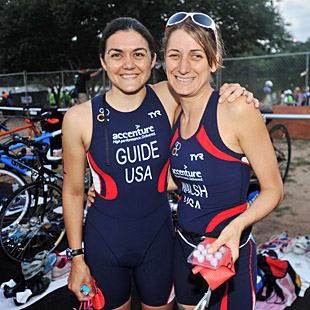
ST: At first glance, it’s hard to tell you are blind.
Patricia: Most people don’t realize how little I see. That happens a lot. That first year I was kind of embarrassed, kind of in shock, so I learned to hide it. That skill stayed with me. In the professional arena it really helped because people didn’t realize I couldn’t see.
ST: Did your disability play any part in getting hired by Microsoft?
Patricia: A lot of people assumed I got a job at Microsoft because of some form of affirmative action. The truth was I didn’t tell them I was blind until I signed on. I already had a contract before I told them.
ST: How did that ability to disguise your blindness help?
Patricia: It really worked to my advantage. The legislation for persons with disabilities in the workplace is really malleable. I know many occasions where a companies had pretty fuzzy reasons for not hiring someone with a disability. In my case it was a non-issue because they didn’t know about it during the interview process. Once I signed a contract, I committed to them. Then we started talking about accessibility.
Every time I felt I didn’t have support, I was very resourceful and did things on my own — and that has paid off big time.
ST: How important is that self reliance?
Patricia: It is very important for any person with a disability to be a self advocate. That skill set will make you or break you.
ST: When did you start work?
Patricia: I started at Microsoft when I was 25 and worked as a software engineer and did coding and software testing for six years.
STARTING ANEW IN SPORT
ST: What did you do to keep fit after high school?
Patricia: When I was about 19, my dad started having some heart attacks and strokes and it occurred to me I had to make major changes. I was a smoker. I was a little bit overweight. I didn’t exercise. My situation wasn't dire, but I was on that track.
ST: What did you do?
Patricia: I told a friend that I was going to run a marathon. The rest of my friends all looked at me and thought, ‘Here is another of Patricia’s crazy ideas!’ But I went right out and ran a mile.
ST: Was anyone guiding you?
Patricia: No. I didn’t understand about guiding for years.
ST: How could you navigate those first runs?
Patricia: I went to a running trail. There is a border where the gravel meets the concrete and also where the gravel meets the grass. I could feel that with my feet and I’d run along that edge.
ST: How did you steer clear of other runners?
Patricia: It’s hard to tell where people are. They don’t make a lot of sound. At first I would go at weird hours like four in the morning or 11 at night when people aren’t around.
ST: Didn’t anyone realize that you were blind?
Patricia: I don’t think so. But my friends did. When I came home after that first run, I had fallen several times and I looked all beaten up. Their attitude was, ‘OK. She is going to learn her lesson. Thank God she is going to get over this quick.’ But I continued. Pretty soon I got a team of five friends to run a half marathon with me. I left all of them behind by the 4th mile. That’s when I realized I had some potential.
ST: How good were you?
Patricia: My first half marathon was around 1:40. Not fast, but respectable. After I left my friends behind I started following random strangers. I would run up on someone running at my pace and say, ‘Hey I am a blind person. I want to run behind you.’ I didn't realize at first that was actually asking a lot.
ST: Were some runners taken aback?
Patricia: It didn’t always go over well, I’ll tell you that. Now I know how to engage with people and create a partnership. Back then sometimes I couldn’t find people and I got lost on some runs and two marathons. It’s not a foolproof system.
ST: What were your next steps as an athlete?
Patricia: It was a long progression. My Microsoft job required 12 hours a day. I was doing marathons on the side and I didn’t have time to train properly so I plateaued at 3:50 to 4 hour marathons. When I decided to do the Ironman, I realized I had to be all in. So I started getting coaches and training like crazy. With cross training, my marathon time got down to 3:30.
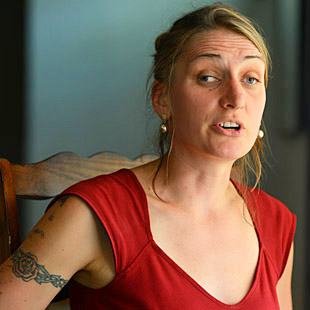
BECOMING A TRIATHLETE
ST: What has been your toughest hurdle in triathlon?
Patricia: I have only recently overcome my panic in the swim. To me it is total sensory deprivation. I just feel lost and anxious not knowing what way the shore is.
ST: How much has this hurt your competitiveness?
Patricia: The Ironman is actually better for me because you have time to recover and the time lost is kind of absorbed. In a sprint triathlon, if you freak out you've bombed the race.
ST: What has helped your swim?
Patricia: I was swimming six days a week and worked hard on my stroke. But all the improvements were lost in open water swimming. This year I went with [Austin professional triathlete and runner] Desiree Ficker to the pool. After a few minutes, Desiree figured out that I wasn't exhaling. If you don’t clear out the CO2, you aren’t getting oxygen in and you panic. In just one session, she cut 20 percent off my swim time and probably saved my triathlon career.
ST: How do you work with the tether in the swim?
Patricia: The biggest challenge with the tether is on the swim. If the guide moves even inches away, your stroke is cut off significantly. If they move toward you, the tether goes slack and you get no signal whatsoever. The aim is to maintain a constant tension because that is the only way of communicating. They have to pull me with the tether or push or punch me. Sounds bad, but when there are 2,000 other people in the water, it can’t be gentle. I’ve come out with bruises on my arms from being punched but it’s fine because communication is crucial.
ST: What about the tether on the run?
Patricia: I like my guide to give me a little more feedback on the tether. Unfortunately, that can start swinging me side to side. You want to run in a straight line for speed. But at Cap Tex, my guide Angie [Balentine] and I figured things out really quickly.
ST: During an Ironman, there must be extra stress?
Patricia: There comes a point when both people’s nerves are shot but that’s just part of the game. You will each have that moment where you’ve just had it. Stress is the natural product of challenging your body to the breaking point. As a blind athlete, I encourage everyone racing with a guide to be grateful every step of the way.
TACKLING IRONMAN
ST: You had not done a triathlon when you decided to do an Ironman. How did it go?
Patricia: I was 29 when I did Ironman Lake Placid in 2010. I had trained for most of a year with Rebecca Fink, a fellow Microsoft employee, as my guide. But five weeks before the race we were riding the tandem bike on a rainy day and crashed and she broke her wrist and elbow. Luckily Carolyn Gayner agreed to fill in but she had only 5 weeks to prepare.
ST: I hear you felt that one Ironman was quite enough.
Patricia: That course was tough. We finished in 14:38 and became the first blind female with a female guide to do an Ironman. Carolyn was amazing and I think she improved her PR by over an hour. The fact that we finished that race was miraculous. But I was a bit faster than she was on the run, and we had a bit of a tug of war. In hindsight, I wasn't as understanding as I should have been and I really feel bad for that.
ST: Sounds like you life was overloaded?
Patricia: I’d leave at 5 AM and get home at 1 AM. Then I’d sleep for about 3 hours. I had two workouts a day in addition to school and my full time job. Ultimately training for an Ironman with those life stresses just destroyed my adrenal system and I had high levels of cortisol.
ST: But you changed your mind.
Patricia: A few weeks later, I got a call that a professional triathlete wanted to do Ironman Texas with me and I said OK. I took a term off school [a graduate program at Seattle University] and I trained more than ever. Unfortunately my guide had to back out three weeks before the race. I understood, but it was devastating. The good news was that the C Different Foundation, which pairs sighted guides with blind triathletes, found two elite athletes training for Kona. Happily, Michelle Ford and Sonja Wieck agreed to guide me and we did it in [11:40:27]. I was really touched when Charlie Plaskon, the guy who had set the blind men’s Ironman record, hugged me and said he was happy I was the one to break his mark.
ST: How much attention did you get?
NEW HORIZONS
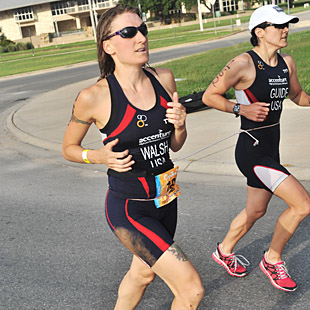
Patricia: I got a lot of national press, which was exciting. As a result, I was added to the USA Triathlon national team. Then I won my category at the 2011 USAT Paratriathlon Nationals in New York. Then I went to Beijing and finished 3rd in my category at the ITU Paratriathlon World Championship.
ST: How did your race go in Beijing?
Patricia: I had a panic attack on the swim and lost 2 minutes. I followed with the 2nd-fastest bike and the fastest run but I was 4 or 5 minutes slower than the top swim time. I really think if I had not panicked we could have won gold. At the finish, my guide Courtney Hill and I were 1:47 behind second place.
ST: How tough was your second win at the Paratriathlon Nationals?
Patricia: I went into it a little more cautiously than usual because I am recovering from injuries. I quit Microsoft in March to focus on athletics (and cut out 10 hours a day I spent sitting at a desk) but two days later, I had an inflamed metatarsal. I couldn’t run for two months..
ST: How bad was the injury?
Patricia: Initially I couldn’t even walk on it. I swam like crazy. Did a lot of elliptical, a lot of weight training. Eventually I worked in some running a few weeks before the race.
ST: What led to your injury?
Patricia: I was trying to qualify for the Paralympics in track. I had improved from a 6 minute mile to a 5:40 and I was trying to get that down to 5 minutes a mile. I was really overdoing it so it was no shock I got hurt. This year’s Paratriathlon nationals in Austin was my comeback.
ST: After quitting Microsoft, how do you support yourself?
Patricia: I do consulting and public speaking and formed my own company – Blind Ambition Speaking. I do about a speech a week.
ST: What makes the strongest impact in your public speaking?
Patricia: When I started, I really thought people would be excited about my athletics. Last week I did a speech in Seattle before 350 people, including the mayor of Seattle and two senators. The feedback was that what really resonates is my transition from a broken child without a support system to a happy person with a well rounded life. Not so much my success at school, work and athletics.
ST: How does your blindness affect friendships now?
Patricia: There were times when I was not receptive to accepting help. Not out of a fear of being a burden. It just never occurred to me. Now I have many wonderful friends who let me know that one of the ways you can become closer is to trust them. It used to be me against the world. Right now, if a friend wants to give me a ride to track practice, I say yes.


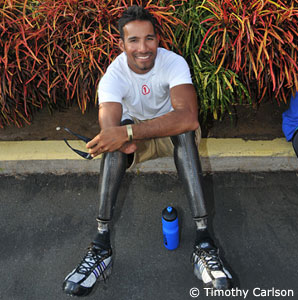
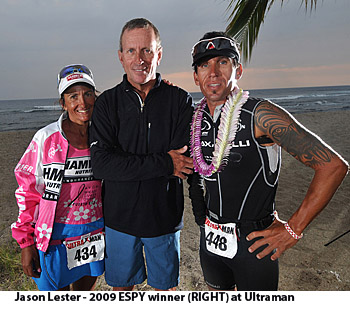
Start the discussion at slowtwitch.northend.network